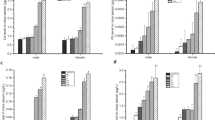Abstract
Copper plays an important role in the structure and function of metalloproteins and in the absorption of iron. The present study deals with the effects of excessive copper intake on hematological and hemorheological parameters.
Drinking water containing 250 µg/mL copper for a period of 9 wk, Wistar albino rats showed increased erythrocyte count, blood viscosity, and hematocrit values (p<0.05) and lower hemoglobin (p<0.05) than controls fed a normal diet. The two groups also had differences in the erythrocyte deformability index.
The results suggest that excessive copper intake results in hematological and hemorheological changes affecting both the protein content of the erythrocyte membrane and heme synthesis.
Similar content being viewed by others
References
P. G. Georgopoules, A. Roy, M. J. Yonone-Lioy, R. E. Opiekun, and P. J. Lioy, Enviromental copper: its dynamics and human exposure issues, J. Toxicol. Environ. Health B 4, 341–394 (2001).
R. Uauy, M. Oliveras, and M. Gonzales, Essentially of copper in humans, Am. J. Clin. Nutr. 67 (Suppl.) 952–959 (1988).
N. Tietz, Textbook of Clinical Chemitry, W. B. Saunders, Philadelphia pp. 965–985 (1981).
G. W. Evans, Copper homeostasis in the mammalian system, Physiol. Rev. 53(53), 535–570 (1973).
W. M. Dunlap, G. W. James, and D. M. Hume, Anemia and neutropenia caused by copper deficiency, Ann. Intern. Med. 80, 470–476 (1974).
G. E. Cartwright and M. N. Wintrobe, Copper metabolism in normal subjects, Am. J. Clin. Nutr. 14, 224–232 (1964).
E. J. Underwood, Trace Elements in Human and Animal Nutrition, 4th ed., Academic P, New York, pp. 56–108 (1977).
P. N. Davis, L. C. Norris, and F. H. Kratzer, Interference of soybean proteins with the utilization of trace minerals, J. Nutr. 77, 217–223 (1962).
W. W. Carlton and W. Handerson, Studies in chickens fed a copper deficient diet supplemented with ascorbic acid, reserpine and diethylstilbestrol, J. Nutr. 85, 67–72 (1965).
C. H. Hill and B. Starcher, Effect of reducing agents on copper deficiency in the chick, J. Nutr. 85, 271–274 (1965).
K. C. Weiss and M. C. Linder, Copper transport in rats involving a new plasma protein, Am. J. Phisiol. 249, E77-E88 (1985).
L. C. Bloomer and G. R. Lee, Normal hepatic copper metabolism, in Metals and the Liver, L. W. Powell, ed., Marcel Dekker, New York (1978).
G. Gregoriadis and T. Sourkes. Intracellular distribution of copper in the liver of the rat, Can. J. Biochem. 45, 1841–1851 (1967).
D. B. Milne and P. H. Weswig, Effect of supplementary copper on blood andliver copper-containing fractions in rats, J. Nutr. 95, 429–433 (1968).
M. C. Linder and M. Hazegh Azam, Copper biochemistry and molecular biology, Am. J. Clin. Nutr. 63, 797–811 (1966).
N. Marceau and N. Aspin, The intracellular distribution of radio-copper derived from ceruloplasmin and from albumin, Biochem. Biophys. Acta. 328(2), 338–350 (1973).
World Health Organization, Trace Elements in Human Nutrition and Health, Who, Geneva pp. 123–141 (1996).
J. T. Saari, A. M. Bode, and G. M. Dahlen, Defects of copper deficiency in rats are modified by dietary treatment that affect glycation, J. Nutr. 125, 2925–2934 (1995).
K. A. Sukalski, T. P. La Berge, and W. T. Johnson, In vivo oxidative modification of erythrocyte membrane proteins in copper deficiency, Free Radical Biol. Med. 22(5), 835–842 (1997).
E. Rock, E. Gueux, A. Mazur, C. Motta, and Y. Rayssiquier, Anemia in copper-deficient rats: role of alterations in erythrocyte membrane fluidity and oxidative damage, Am. J. Physiol. 269(5), 1245–1249 (1995).
T. M. Amin, J. A. Sirs, and P. Turner, Measurement of erythrocyte deformability using a stroboscopic recording centrifuge, Phys. Med. Biol. 28(Suppl.3), 269–275 (1983).
D. S. Erdinçler, Y. Karakoç, S. Toplan, S. Önen, A. Sukyasyan, T. Beger, et al. The effect of ginkgo biloba glycoside on blood viscosity and erythrocyte deformability, Clin. Hemorheology 16(3), 271–276 (1996).
J. D. Bauer, Viscosity of blood, in Gradwohl’s Clinical Laboratory Methods and Diagnosis, F. S. Reitman and A. C. Sonnenwirt, eds., Mosby, St. Louis, MO, pp. 492–493 (1970).
A. A. Famadu, Hemorheological changes and fibrinolytic activity in adult asthmatic patients with sickle cell trait (HbAS), Clin. Hemorheol. Microcirc. 19, 1–5 (1998).
A. Brown, and A. Taylor, Applications of a slotted quartz tube and flame atomic absorption spectrometry to the analysis of biological samples, Analyst 110, 579–582 (1985).
J. N. Arora and G. J. Gores, Role of metals in ischemic reperfusion injury, Semin. Liver Dis. 16(1), 28–38 (1996).
M. L. Shilsky, Wilson’s disease: genetic basis of copper toxicity and natural history, Semin. Liver Dis. 16(1), 83–95 (1996).
I. Fridovich, Superoxide dismutases, Adv. Enzymol. Related Areas Mol. Biol. 41(0), 35–97 (1974).
G. R. Lee and V. Herbert, Nutritional factors in the production and function of erythrocytes, in Wintrobe§ Clinical Hematology, 10th ed., G. R. Lee G., J. Foerster, J. Lukens, F. Paraskev, J. P. Greer, and G. M. Rodgers, eds., Williams & Wilkins, Baltimore, MD, Vol. I, pp. 228–266 (1999).
B. M. Myers, B. A. Hamilton, and M. L. Shilsky, Proliferation of hepatic lysosomes and autophagic vacuoles in the LEC rat, Hepatology 22, 373A (1995).
K. Gwozdzinski, A spin label study of the action of cupric and mercuric ions on human red blood cells, Toxicology 65(3), 315–323 (1991).
Z. S. Jehan and D. B. Matlag, Metal induced changes in the erythrocyte membrane of rats, Toxicol. Lett. 78(2), 127–133 (1995).
D. Gelvan and P. Saltman, Different cellular targets for cupper and iron catalyzed oxidation observed using a copper-compatible thiobarbituric acid assay, Biochem. Biophys. Acta 1035(3), 353–360 (1990).
A. S. Prasad, Trace Elements and Iron in Human Metabolism, Wiley, London, pp. 289–303 (1978).
Author information
Authors and Affiliations
Rights and permissions
About this article
Cite this article
Özçelik, D., Toplan, S., Özdemir, S. et al. Effects of excessive copper intake on hematological and hemorheological parameters. Biol Trace Elem Res 89, 35–42 (2002). https://doi.org/10.1385/BTER:89:1:35
Received:
Revised:
Accepted:
Issue Date:
DOI: https://doi.org/10.1385/BTER:89:1:35



